Thermal Effectiveness Enhancement of Autoclaved Aerated Concrete Wall with PCM-Contained Conical Holes to Reduce the Cooling Load
Abstract
1. Introduction
2. Materials and Methods
2.1. Analysis of Behavior and Application of Phase Change Material
2.2. Testing the Thermal Behavior of the AAC Modifications under Controlled Temperature Versus with Actual Weather
3. Results
3.1. Phase Change Material Behavior
3.2. Time Lag and Decrement Factor Measurement
4. Conclusions
Author Contributions
Funding
Acknowledgments
Conflicts of Interest
References
- Ürge-Vorsatz, D.; Cabeza, L.F.; Serrano, S.; Barreneche, C.; Petrichenko, K. Heating and cooling energy trends and drivers in buildings. Renew. Sustain. Energy Rev. 2015, 41, 85–98. [Google Scholar] [CrossRef]
- Ürge-Vorsatz, D.; Petrichenko, K.; Staniec, M.; Eom, J. Energy use in buildings in a long-term perspective. Curr. Opin. Environ. Sustain. 2013, 5, 141–151. [Google Scholar] [CrossRef]
- Chan, A.L.S.; Chow, T.T. Evaluation of Overall Thermal Transfer Value (OTTV) for commercial buildings constructed with green roof. Appl. Energy 2013, 107, 10–24. [Google Scholar] [CrossRef]
- Yang, L.J.; Yang, E.H. Energy performance of building envelopes integrated with phase change materials for cooling load reduction in tropical Singapore. Appl. Energy 2016, 162, 207–217. [Google Scholar]
- Levinson, R.; Berdahl, P.; Akbari, H.; Miller, W.; Joedicke, I.; Reilly, J.; Suzuki, Y.; Vondran, M. Methods of creating solar-reflective nonwhite surfaces and their application to residential roofing materials. Sol. Energy Mater. Sol. Cells 2007, 91, 304–314. [Google Scholar] [CrossRef]
- Nahar, N.M.; Sharma, P.; Purohit, M.M. Performance of different passive techniques for cooling of buildings in arid regions. Build. Environ. 2003, 38, 109–116. [Google Scholar] [CrossRef]
- Golewski, G.L. The influence of microcrack width on the mechanical parameters in concrete with the addition of fly ash: Consideration of technological and ecological benefits. Constr. Build. Mater. 2019, 197, 849–861. [Google Scholar] [CrossRef]
- Golewski, G.L. An assessment of microcracks in the Interfacial Transition Zone of durable concrete composites with fly ash additives. Compos. Struct. 2018, 200, 515–520. [Google Scholar] [CrossRef]
- Pan, J.; Zou, R.; Jin, F. Experimental study on specific heat of concrete at high temperatures and its influence on thermal energy storage. Energies 2017, 10, 33. [Google Scholar] [CrossRef]
- Ogrodnik, P.; Zegardło, B.; Szeląg, M. The use of heat-resistant concrete made with ceramic sanitary ware waste for a thermal energy storage. Appl. Sci. 2017, 7, 1303. [Google Scholar] [CrossRef]
- Wu, C.; Pan, J.; Zhong, W.; Jin, F. Testing of high thermal cycling stability of low strength concrete as a thermal energy storage material. Appl. Sci. 2016, 6, 271. [Google Scholar] [CrossRef]
- Sharma, A.; Tyagi, V.V.; Chen, C.R.; Buddhi, D. Review on thermal energy storage with phase change materials and applications. Renew. Sustain. Energy Rev. 2009, 13, 318–345. [Google Scholar] [CrossRef]
- Farid, M.M.; Khudhair, A.M.; Razack, S.A.K.; Al-Hallaj, S. A review on phase change energy storage: Materials and applications. Energy Convers. Manag. 2004, 45, 1597–1615. [Google Scholar] [CrossRef]
- Fernandes, D.; Pitié, F.; Cáceres, G.; Baeyens, J. Thermal energy storage: How previous findings determine current research priorities. Energy 2012, 39, 246–257. [Google Scholar] [CrossRef]
- Zhou, G.B.; Pang, M.M. Experimental investigations on thermal performance of phase change material–Trombe wall system enhanced by delta winglet vortex generators. Energy 2015, 93, 758–769. [Google Scholar] [CrossRef]
- Li, S.S.; Zhu, N.; Hu, P.F.; Lei, F.; Deng, R. Numerical study on thermal performance of PCM trombe wall. Energy Procedia 2019, 158, 2441–2447. [Google Scholar] [CrossRef]
- Omari, K.E.; Guer, Y.L.; Bruel, P. Analysis of micro-dispersed PCM-composite boards behavior in a building’s wall for different seasons. J. Build. Eng. 2016, 7, 361–371. [Google Scholar] [CrossRef]
- Oliver, A. Thermal characterization of gypsum boards with PCM included: Thermal energy storage in buildings through latent heat. Energy Build. 2012, 48, 1–7. [Google Scholar] [CrossRef]
- Li, D.; Wu, Y.; Liu, C.; Zhang, G.; Arıcı, M. Energy investigation of glazed windows containing Nano-PCM in different seasons. Energy Convers. Manag. 2018, 172, 119–128. [Google Scholar] [CrossRef]
- Yasin, M.; Scheidemantel, E.; Klinker, F.; Weinläder, H.; Weismann, S. Generation of a simulation model for chilled PCM ceilings in TRNSYS and validation with real scale building data. J. Build. Eng. 2019, 22, 372–382. [Google Scholar] [CrossRef]
- Alizadeh, M.; Sadrameli, S.M. Indoor thermal comfort assessment using PCM based storage system integrated with ceiling fan ventilation: Experimental design and response surface approach. Energy Build. 2019, 188–189, 297–313. [Google Scholar] [CrossRef]
- Chou, H.M.; Chen, C.R.; Nguyen, V.L. A new design of metal-sheet cool roof using PCM. Energy Build. 2013, 57, 42–50. [Google Scholar] [CrossRef]
- Lei, J.W.; Kumarsamy, K.; Zingre, K.T.; Yang, J.; Wan, M.P.; Yang, E.H. Cool colored coating and phase change materials as complementary cooling strategy for building cooling load reduction in tropics. Appl. Energy 2017, 190, 57–63. [Google Scholar] [CrossRef]
- Alawadhi, M.E.; Alqallaf, H.J. Building roof with conical holes containing PCM to reduce the cooling load: Numerical study. Energy Convers. Manag. 2011, 52, 2958–2964. [Google Scholar] [CrossRef]
- Koronthalyova, O. Moisture storage capacity and microstructure of ceramic brick and autoclaved aerated concrete. Constr. Build. Mater. 2011, 25, 879–885. [Google Scholar] [CrossRef]
- Kurama, H.; Topcu, I.B.; Karakurt, C. Properties of the autoclaved aerated concrete produced from coal bottom ash. J. Mater. Process. Technol. 2009, 209, 767–773. [Google Scholar] [CrossRef]
- Cai, L.X.; Ma, B.G.; Li, X.G.; Yang, L.; Liu, Z.L.; Jian, S.W. Mechanical and hydration characteristics of autoclaved aerated concrete (AAC) containing iron-tailings: Effect of content and fineness. Constr. Build. Mater. 2016, 128, 361–372. [Google Scholar] [CrossRef]
- Thongtha, A.; Maneewan, S.; Punlek, C.; Ungkoon, Y. Investigation of the compressive strength, time lags and decrement factors of AAC-lightweight concrete containing sugar sediment waste. Energy Build. 2014, 84, 516–525. [Google Scholar] [CrossRef]
- Punlek, C.; Maneewan, S.; Thongtha, A. Phase change material coating on autoclaved aerated lightweight concrete for cooling load reduction. Mater. Sci. 2017, 23, 145–149. [Google Scholar] [CrossRef]
- Ng, S.C.; Low, K.S.; Tioh, N.H. Newspaper sandwiched aerated lightweight concrete wall panels-Thermal inertia, transient thermal behavior and surface temperature prediction. Energy Build. 2011, 43, 1636–1645. [Google Scholar] [CrossRef]
- Asan, H. Effects of wall’s insulation thickness and position on time lag and decrement factor. Energy Build. 1998, 28, 299–305. [Google Scholar] [CrossRef]
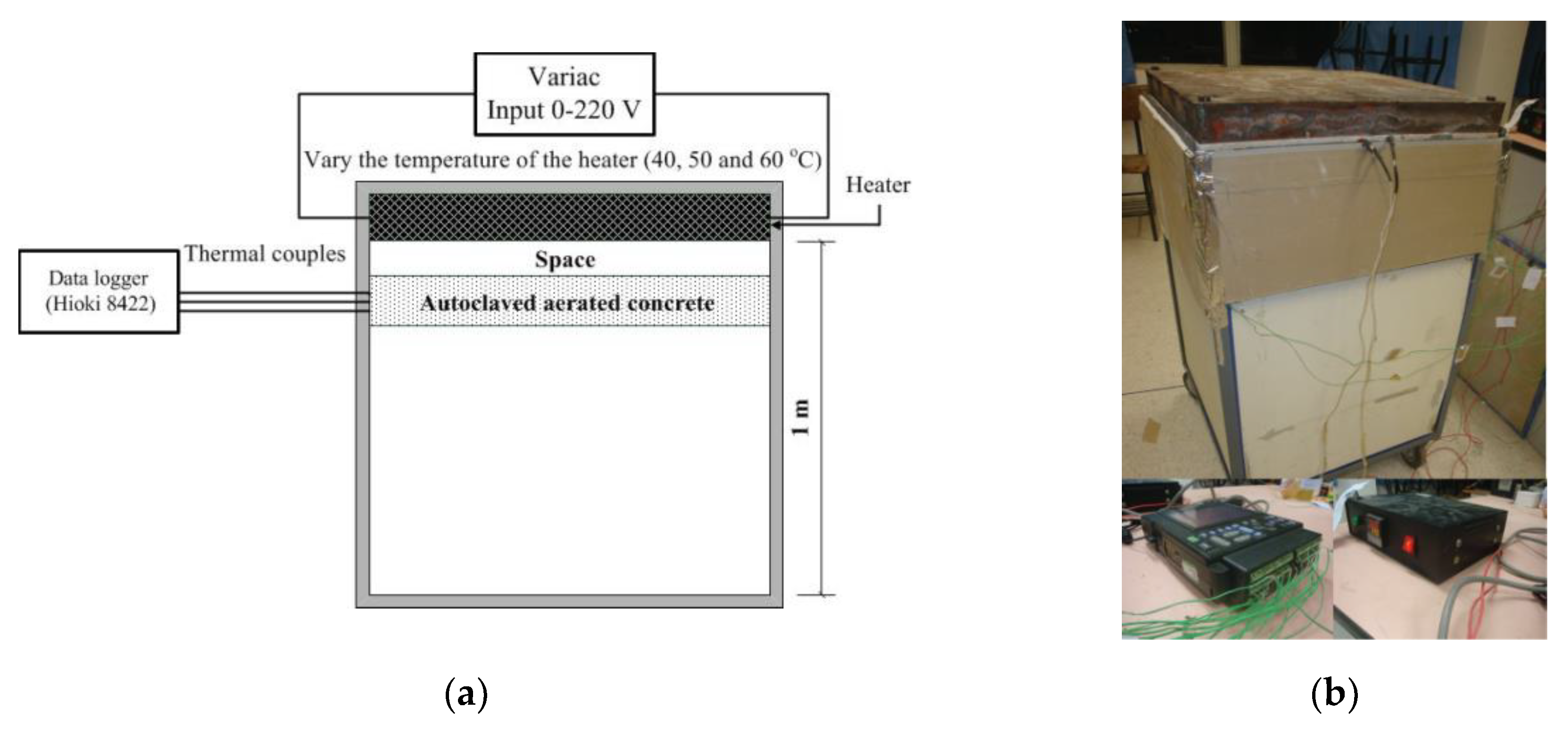
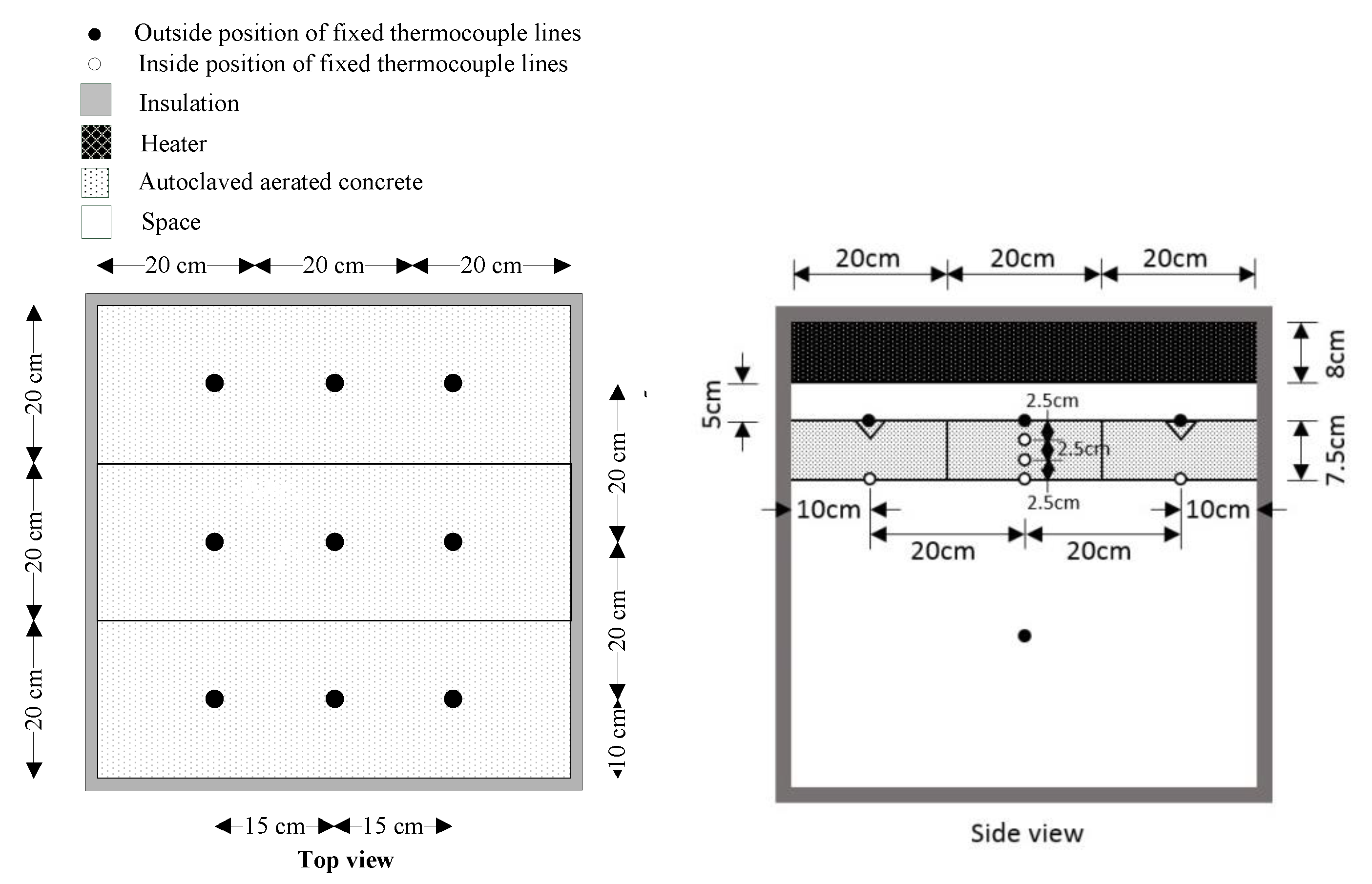

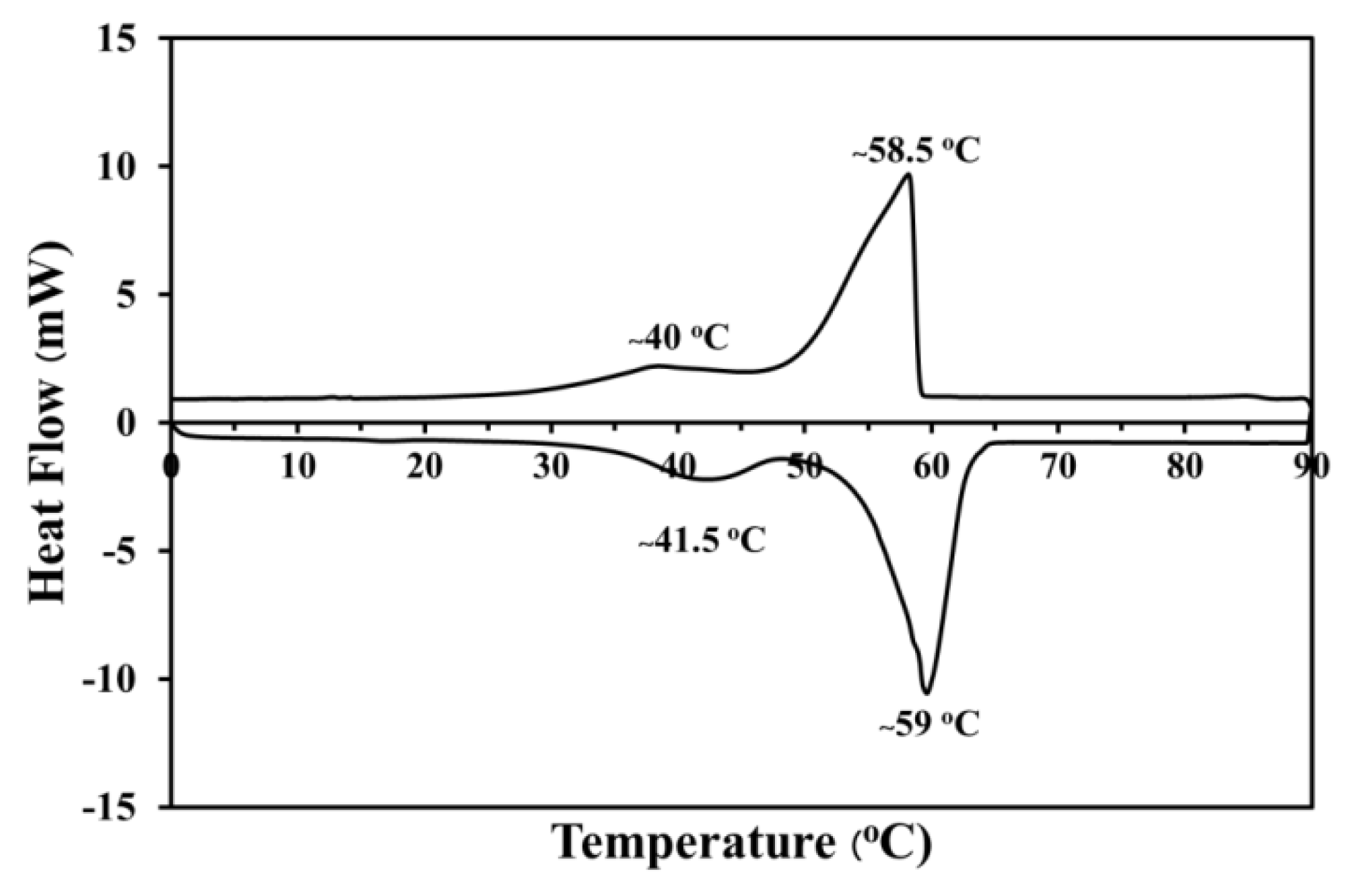
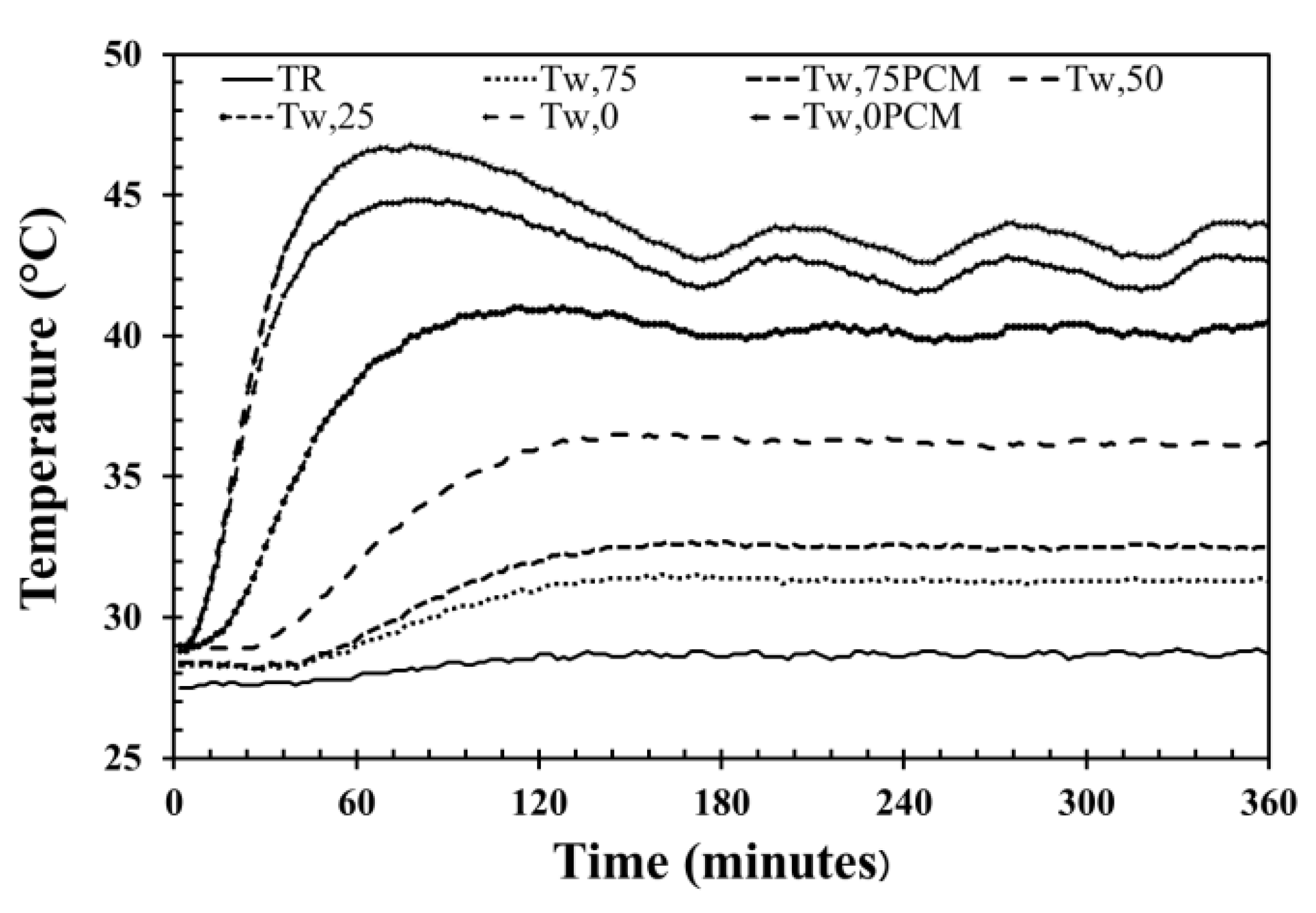
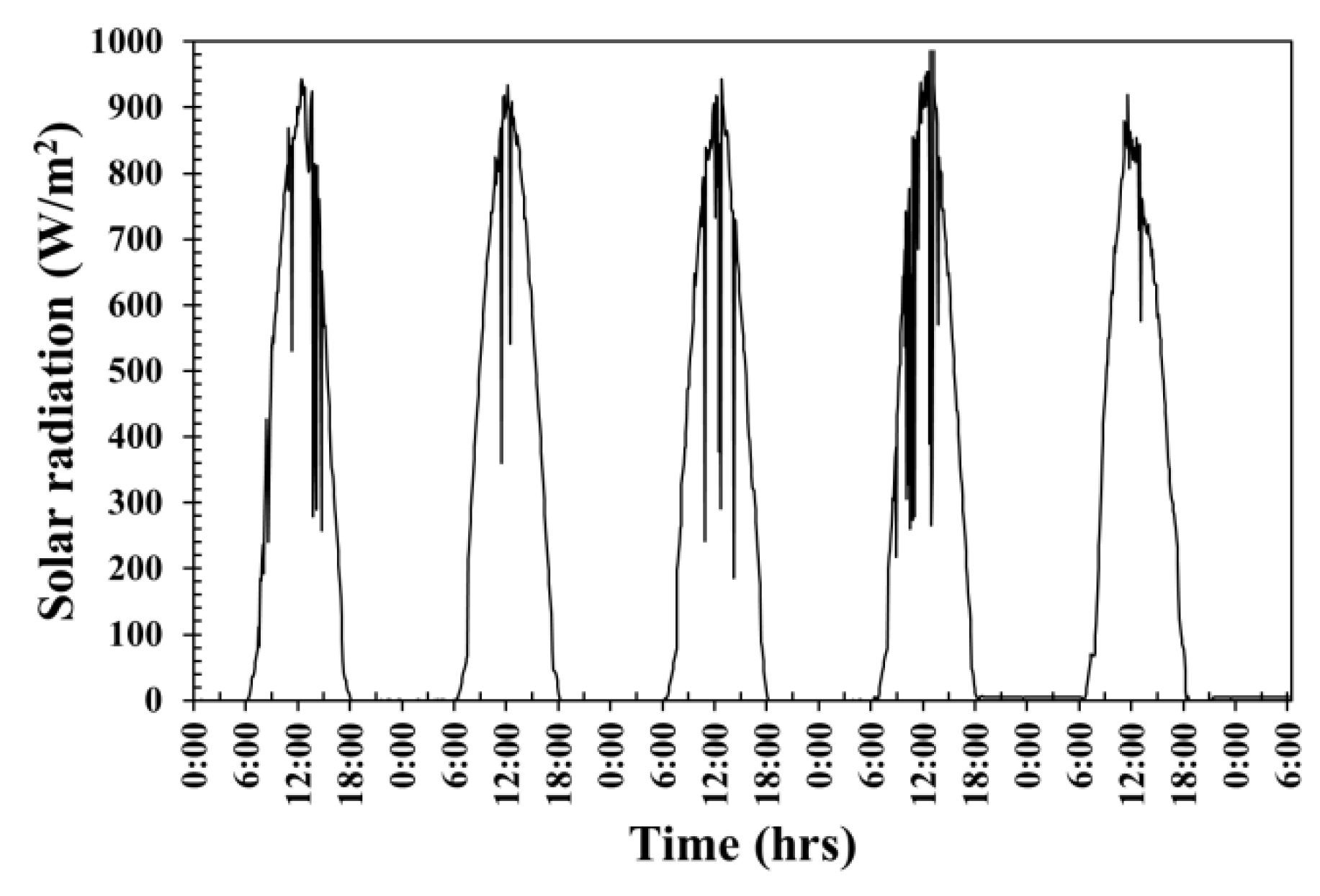
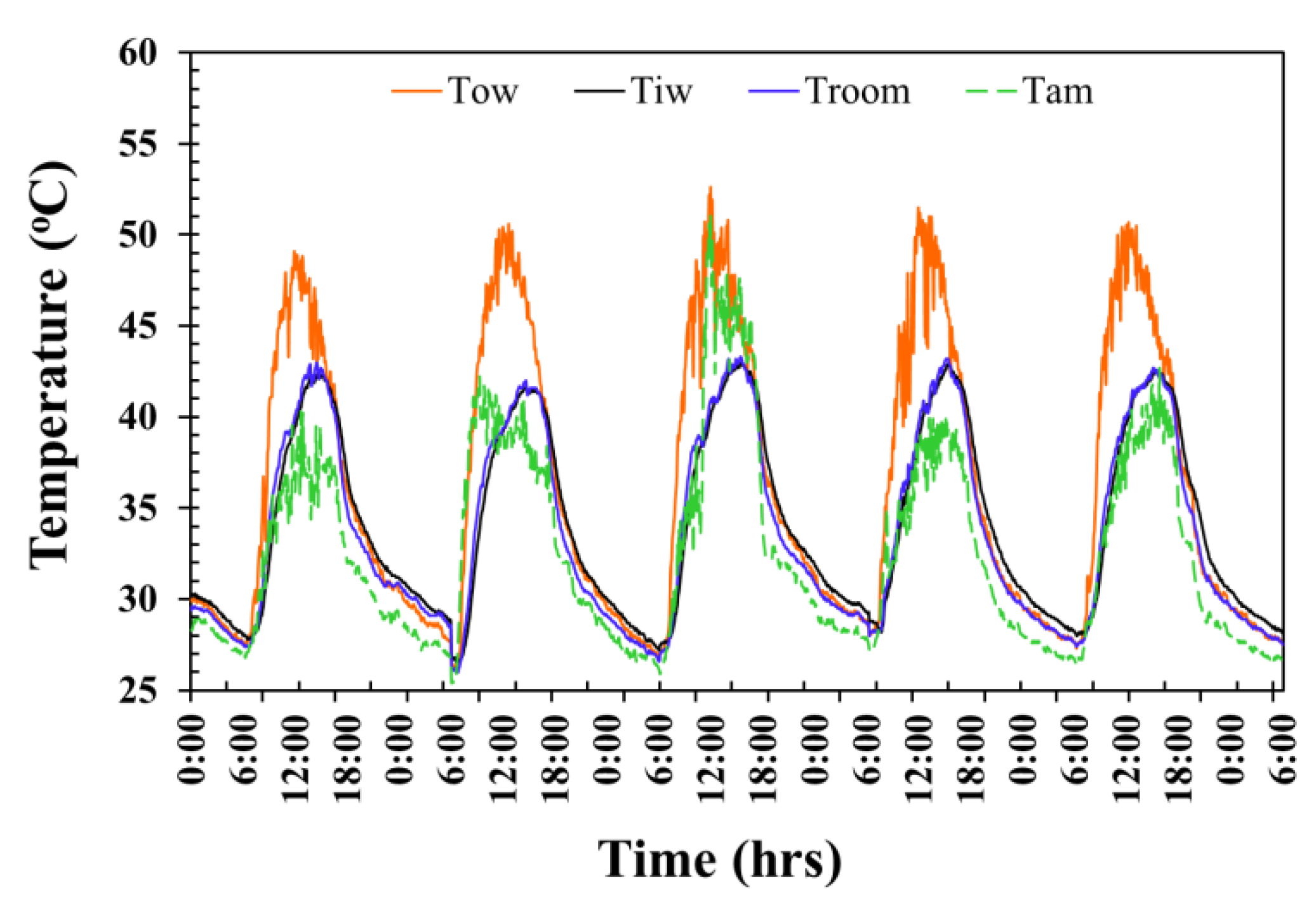
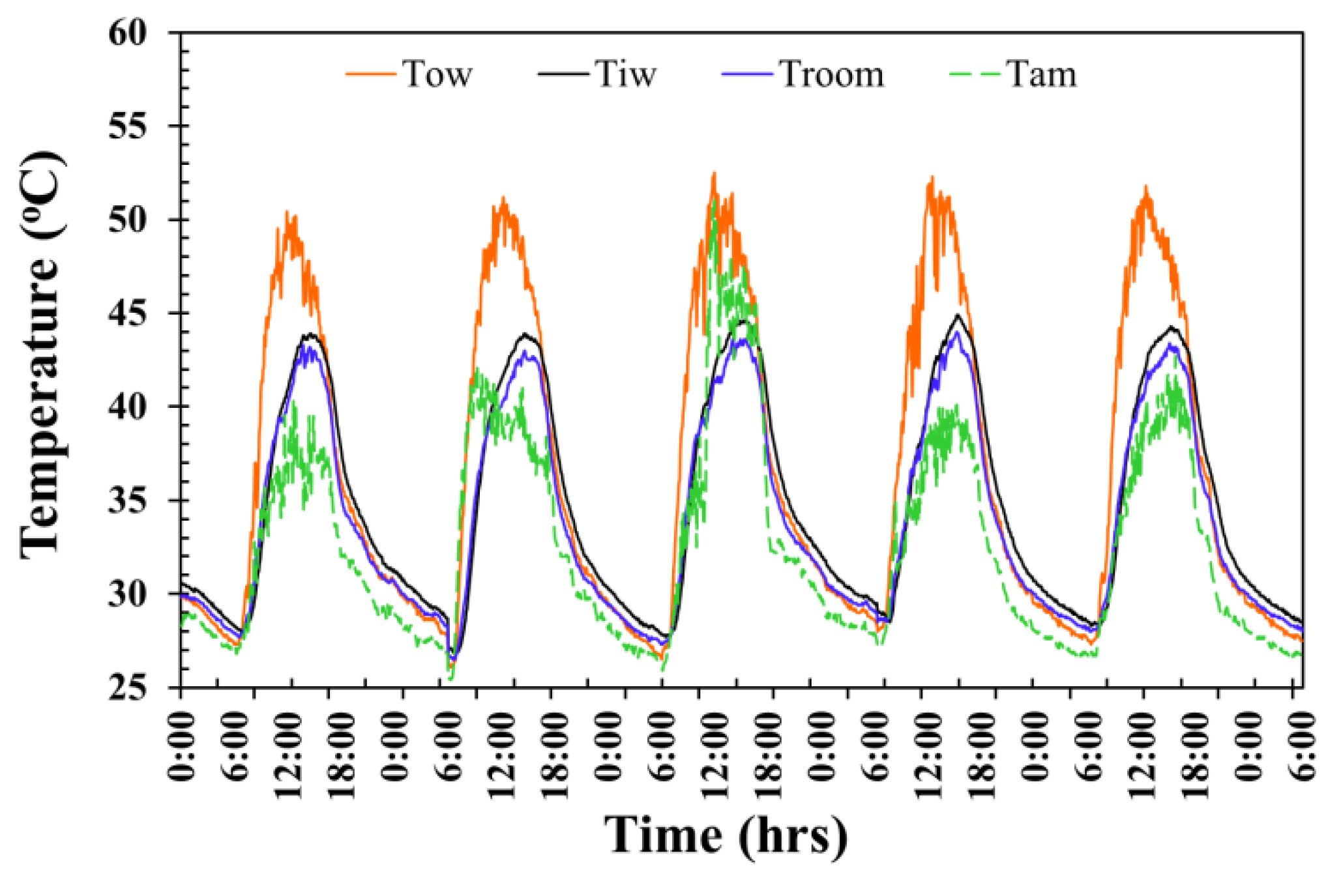
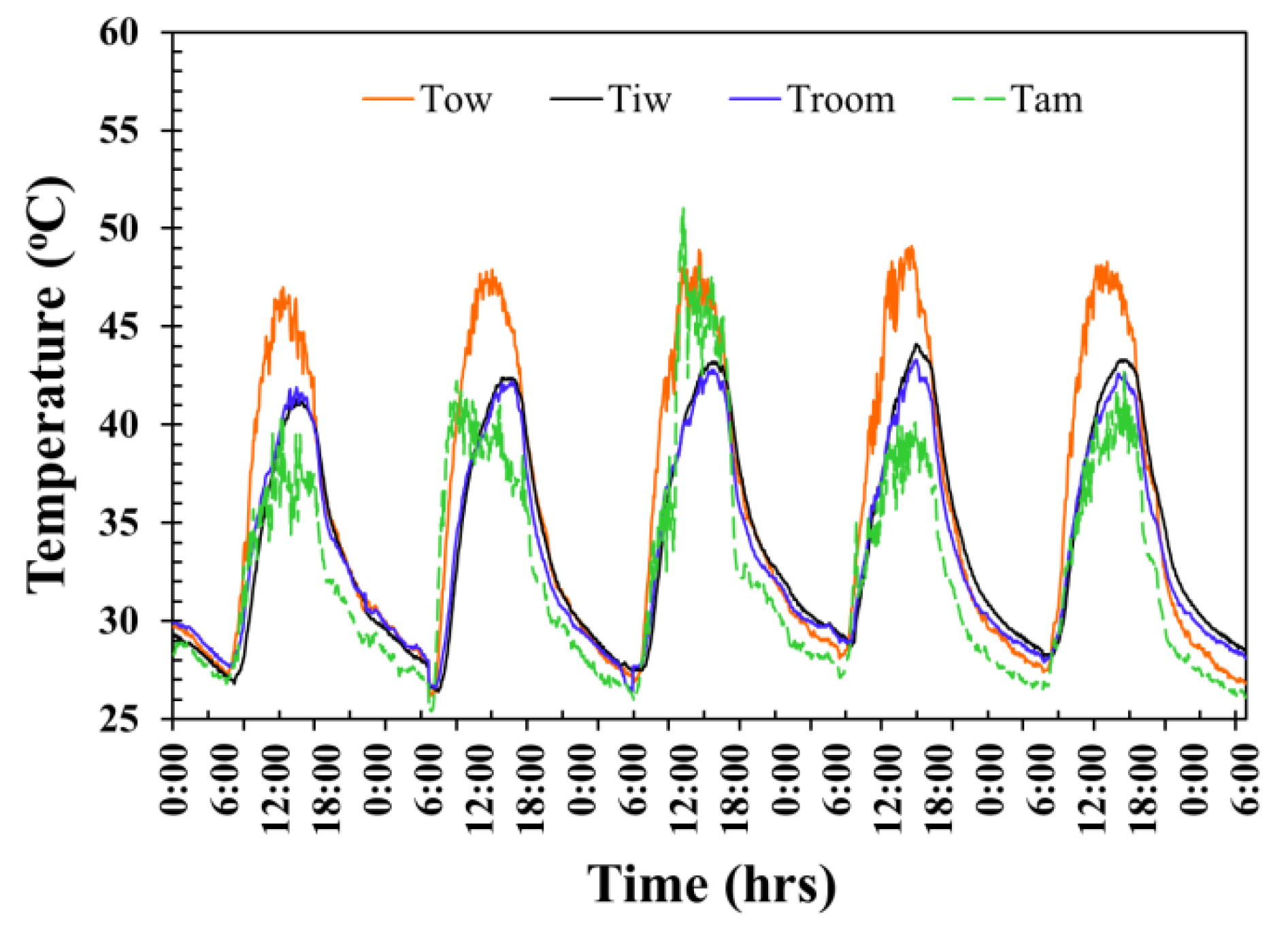
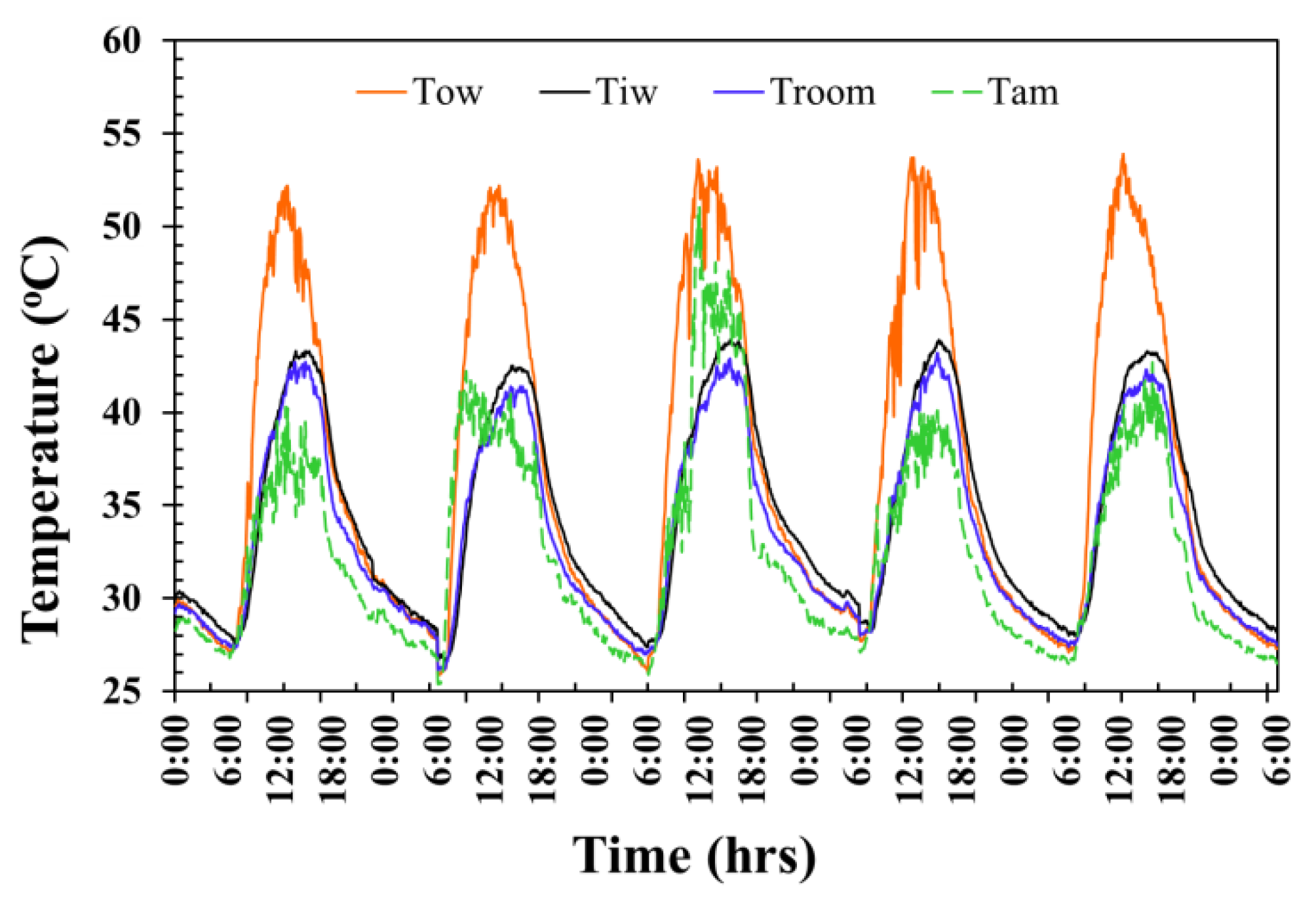
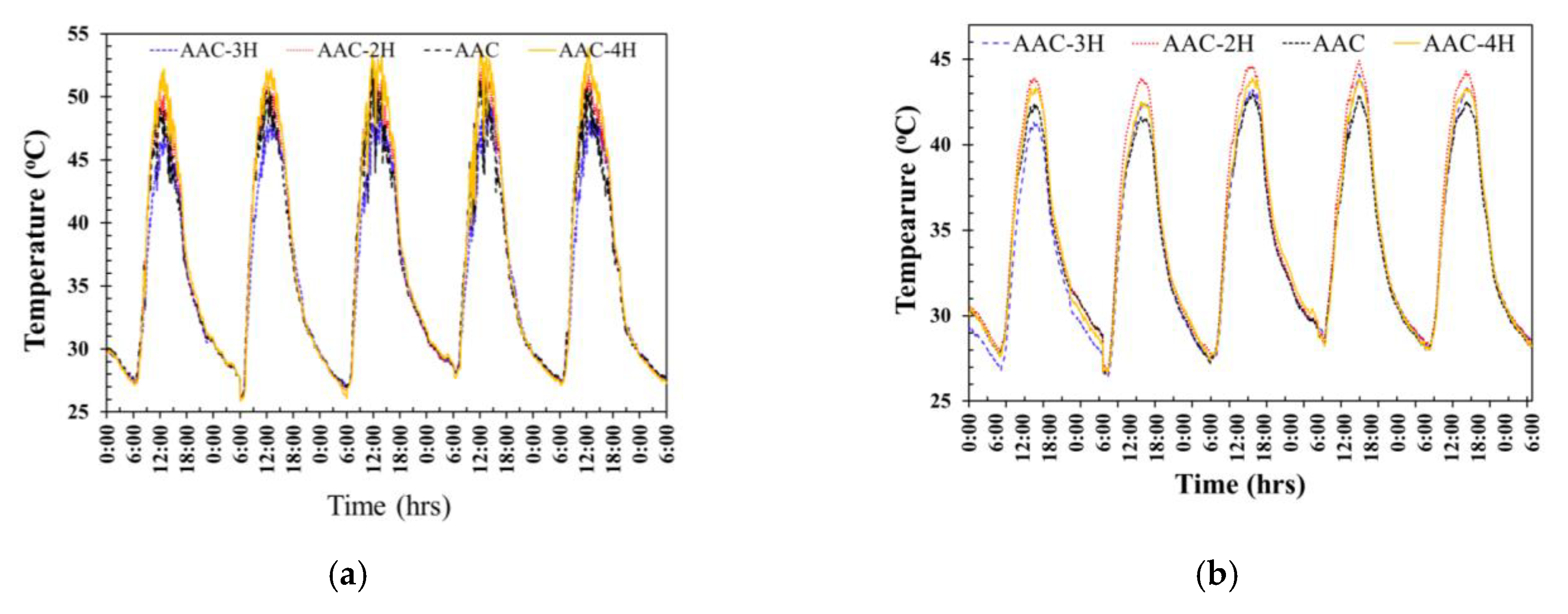

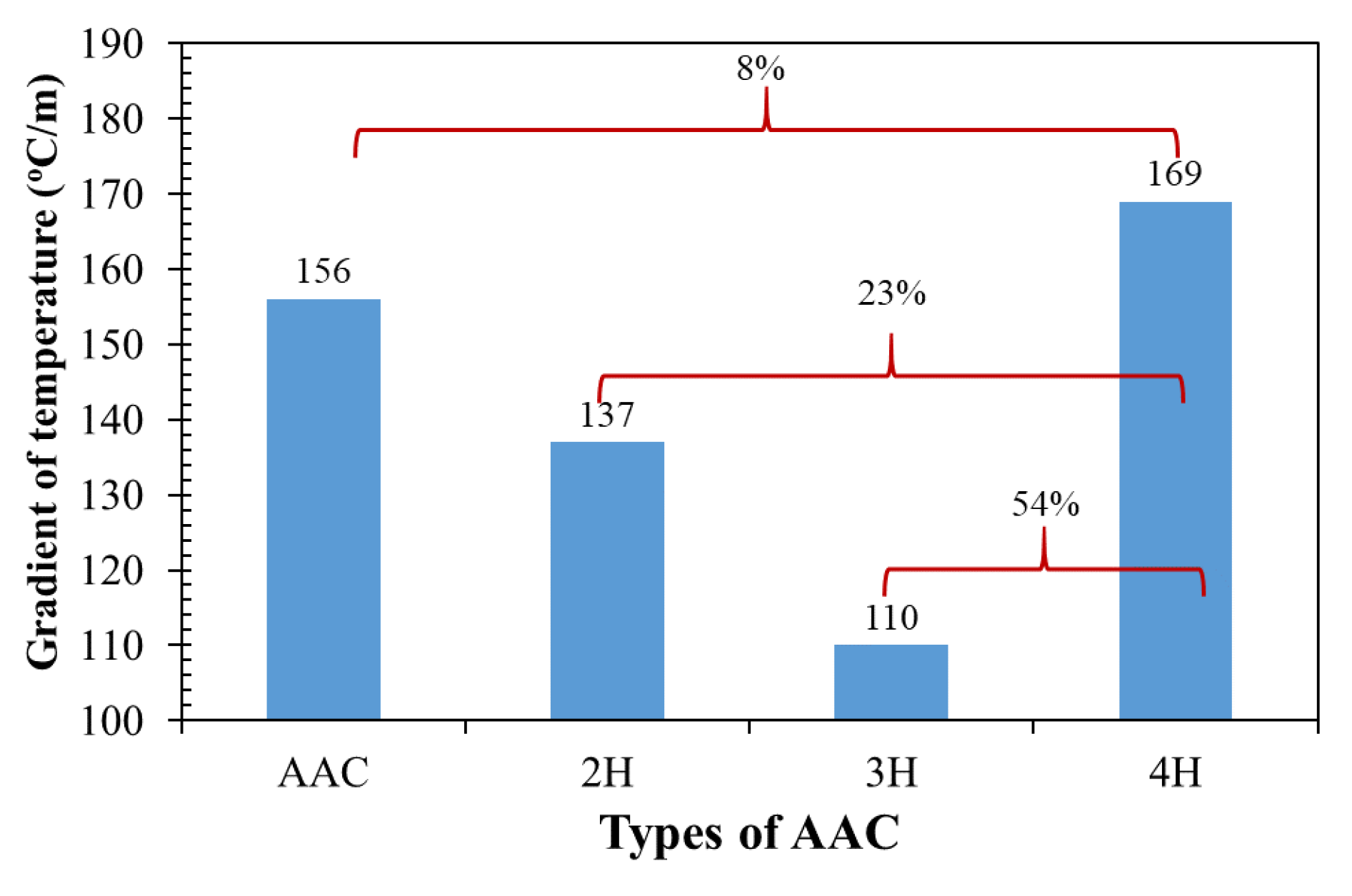
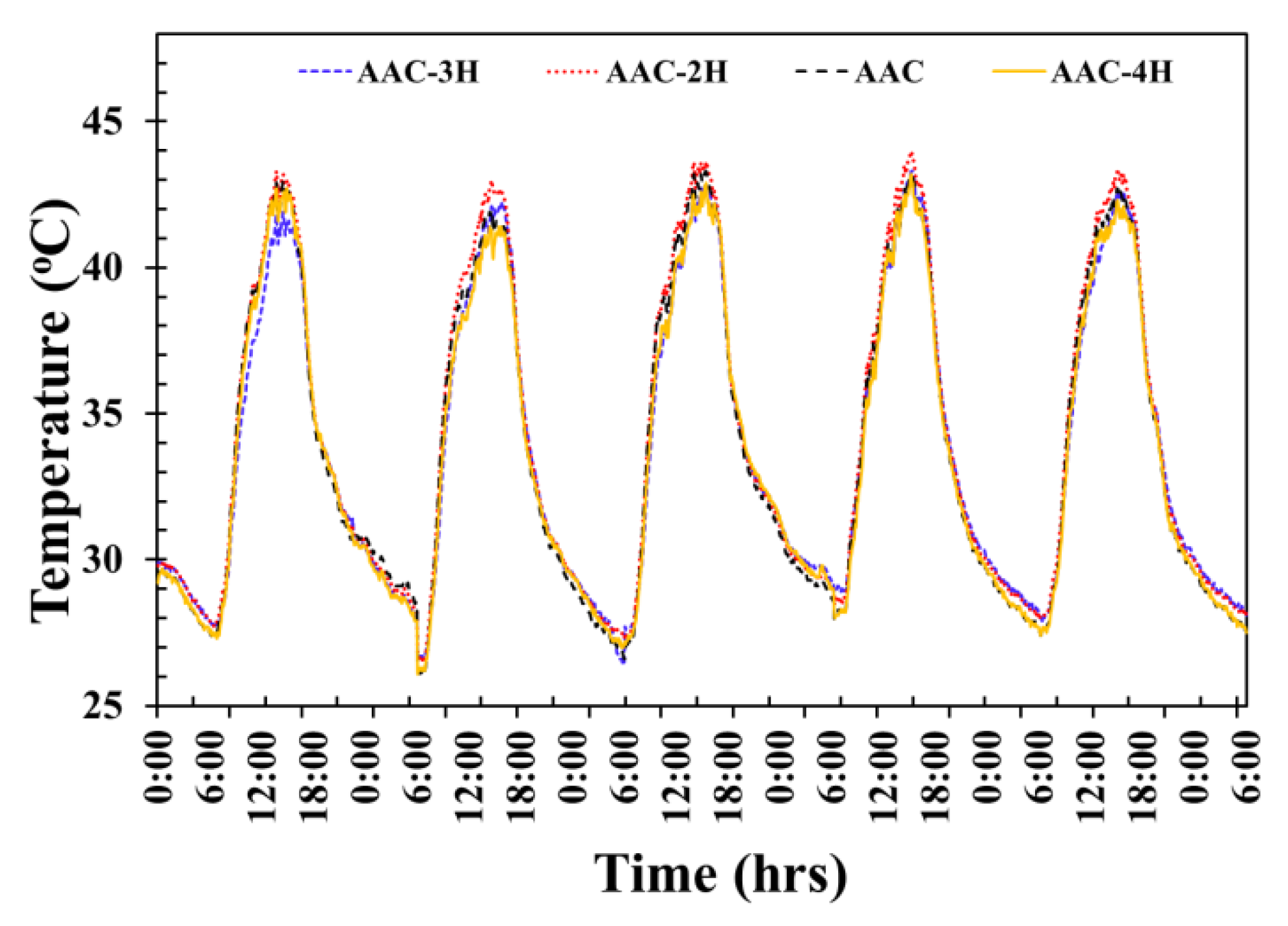
| Average Wall Temperature (°C) | |||||
|---|---|---|---|---|---|
| Temperature (°C) | x (mm) | AAC | AAC-2H | AAC-3H | AAC-4H |
| 0 | 43.1 | 43.3 | 42.6 | 42.4 | |
| 40 | 25 | 38.8 | 39.2 | 38.6 | 38.2 |
| 50 | 33.9 | 35.0 | 34.6 | 34.1 | |
| 75 | 30.9 | 31.7 | 30.9 | 30.8 | |
| 0 | 48.8 | 48.9 | 48.1 | 47.2 | |
| 50 | 25 | 43.3 | 43.1 | 44.3 | 43.5 |
| 50 | 36.9 | 37.0 | 39.1 | 37.2 | |
| 75 | 32.7 | 32.6 | 33.7 | 32.6 | |
| 0 | 50.5 | 55.7 | 52.5 | 49.2 | |
| 60 | 25 | 45.5 | 48.6 | 46.7 | 46.2 |
| 50 | 38.7 | 40.8 | 40.0 | 38.2 | |
| 75 | 33.8 | 34.8 | 33.5 | 31.2 | |
| Decrement Factor | |||||
|---|---|---|---|---|---|
| Temperature (°C) | x (mm) | AAC | AAC-2H | AAC-3H | AAC-4H |
| 0 | 0 | 0 | 0 | 0 | |
| 40 | 25 | 0.328 | 0.443 | 0.383 | 0.356 |
| 50 | 0.133 | 0.378 | 0.102 | 0.178 | |
| 75 | 0.129 | 0.195 | 0.054 | 0.089 | |
| 0 | 0 | 0 | 0 | 0 | |
| 50 | 25 | 0.329 | 0.293 | 0.236 | 0.302 |
| 50 | 0.230 | 0.133 | 0.088 | 0.147 | |
| 75 | 0.176 | 0.090 | 0.042 | 0.099 | |
| 0 | 0 | 0 | 0 | 0 | |
| 60 | 25 | 0.302 | 0.326 | 0.418 | 0.254 |
| 50 | 0.181 | 0.114 | 0.208 | 0.127 | |
| 75 | 0.085 | 0.060 | 0.097 | 0.059 | |
| Type of AAC | Time Lag (Φ) at Different Thicknesses (min) | |||
|---|---|---|---|---|
| 0 mm | 25 mm | 50 mm | 75 mm | |
| AAC | 0 | 34 | 78 | 90 |
| AAC-2H | 0 | 14 | 52 | 58 |
| AAC-3H | 0 | 16 | 44 | 52 |
| AAC-4H | 0 | 16 | 48 | 114 |
| Average Room Temperature (°C) | ||||
|---|---|---|---|---|
| T(°C) | Ordinary AAC | AAC-2H | AAC-3H | AAC-4H |
| 40 | 28.5 | 28.5 | 29.1 | 28.7 |
| 50 | 29.3 | 29.4 | 30.0 | 27.2 |
| 60 | 29.4 | 30.0 | 30.1 | 26.7 |
| Material Types | Time Lag (min) | Decrement Factor | ||||||||||
|---|---|---|---|---|---|---|---|---|---|---|---|---|
| 1st | 2nd | 3rd | 4th | 5th | Avg. | 1st | 2nd | 3rd | 4th | 5th | Avg. | |
| AAC | 156 | 140 | 174 | 166 | 170 | 161 | 0.679 | 0.600 | 0.605 | 0.617 | 0.622 | 0.625 |
| AAC-2H | 150 | 110 | 165 | 160 | 148 | 147 | 0.688 | 0.665 | 0.660 | 0.661 | 0.653 | 0.666 |
| AAC-3H | 160 | 144 | 170 | 150 | 160 | 154 | 0.736 | 0.757 | 0.714 | 0.726 | 0.722 | 0.731 |
| AAC-4H | 170 | 160 | 220 | 190 | 180 | 184 | 0.625 | 0.594 | 0.604 | 0.595 | 0.571 | 0.598 |
© 2019 by the authors. Licensee MDPI, Basel, Switzerland. This article is an open access article distributed under the terms and conditions of the Creative Commons Attribution (CC BY) license (http://creativecommons.org/licenses/by/4.0/).
Share and Cite
Thongtha, A.; Khongthon, A.; Boonsri, T.; Hoy-Yen, C. Thermal Effectiveness Enhancement of Autoclaved Aerated Concrete Wall with PCM-Contained Conical Holes to Reduce the Cooling Load. Materials 2019, 12, 2170. https://doi.org/10.3390/ma12132170
Thongtha A, Khongthon A, Boonsri T, Hoy-Yen C. Thermal Effectiveness Enhancement of Autoclaved Aerated Concrete Wall with PCM-Contained Conical Holes to Reduce the Cooling Load. Materials. 2019; 12(13):2170. https://doi.org/10.3390/ma12132170
Chicago/Turabian StyleThongtha, Atthakorn, Aitthi Khongthon, Thitinun Boonsri, and Chan Hoy-Yen. 2019. "Thermal Effectiveness Enhancement of Autoclaved Aerated Concrete Wall with PCM-Contained Conical Holes to Reduce the Cooling Load" Materials 12, no. 13: 2170. https://doi.org/10.3390/ma12132170
APA StyleThongtha, A., Khongthon, A., Boonsri, T., & Hoy-Yen, C. (2019). Thermal Effectiveness Enhancement of Autoclaved Aerated Concrete Wall with PCM-Contained Conical Holes to Reduce the Cooling Load. Materials, 12(13), 2170. https://doi.org/10.3390/ma12132170




